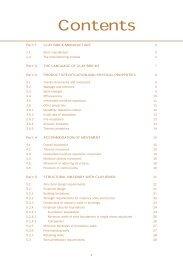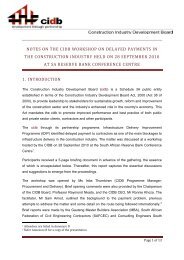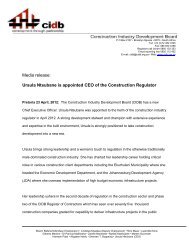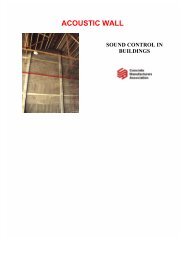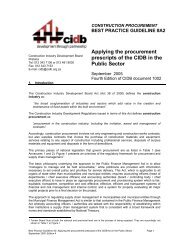MANUAL 4 - Construction Industry Development Board
MANUAL 4 - Construction Industry Development Board
MANUAL 4 - Construction Industry Development Board
Create successful ePaper yourself
Turn your PDF publications into a flip-book with our unique Google optimized e-Paper software.
MODULE<br />
1<br />
2<br />
3<br />
4<br />
5<br />
6<br />
7<br />
<strong>MANUAL</strong> 4 – BITUMINOUS PAVEMENT SEALS<br />
Bulking of aggregate<br />
Bulking of the aggregate is a problem which must be addressed especially if the aggregate<br />
is damp. If the aggregate is dry, there is no problem. But normally aggregate supplied from<br />
the crusher is damp and the problem will arise when part of the heap is damp and part dry.<br />
To overcome this, thoroughly wet the heap to be used with a hose some 6 to 8 hours or more<br />
before use (and cover the heap with a plastic cover). Find the degree of bulking using the<br />
following procedure:<br />
1. Determine the inside height of a 25 litre can (y).<br />
2. Fill the 25 litre can with damp material in the normal way when feeding the concrete<br />
mixer.<br />
3. Strike off the excess material in the can and level with the top of the can.<br />
4. Add water to the can of aggregate until completely saturated, making sure all the air<br />
is released by rodding the can with a thin rod (e.g. rake handle or reinforcing bar).<br />
5. Pour off excess water and measure the drop in height of the aggregate (say x).<br />
6. Then x/y will give the degree of bulking (bulking factor) for adjustments of the quantity<br />
of emulsion to be used in the mix.<br />
Figure 4.16<br />
Therefore, if the quantity of emulsion to be used in the mix is 290 litres/m³, this amount of<br />
emulsion must be reduced by a factor of x/y i.e. x/y times 290.<br />
The amount of emulsion to be used per m³ is therefore:<br />
290 – (x/y) 3 290 = 290 (1- x/y) litres.<br />
Note<br />
Using uniformly damp aggregate reduces the amount of water to be added to the<br />
mixture to produce the slurry. It also overcomes the problem of balling of the fines when<br />
emulsion is added.<br />
If the aggregate to be used is completely dry it is recommended that a small amount of<br />
water be added to the aggregate in the mixture after adding the cement to ensure no<br />
balling of the mix takes place when the emulsion is added.<br />
IMPLEMENTING EMPLOYMENT INTENSIVE ROAD WORKS 72





